Worlds in Information: On Magic’s World Guides
A paean to Miguel Lopez, Emily Teng, and Neale La Plante Johnson
In theory, encyclopedias should not be fun.
An encyclopedia entry is not like a story. It is minimally aestheticized. It does not have the feeling of immediacy that narrative does, that sense that a story is “happening” as we watch it. As Walter Benjamin argues,“[i]t is not the object of a story to convey a happening per se, which is the purpose of information; rather, it embeds it in the life of the storyteller in order to pass it on as an experience to those listening.” For Benjamin, information isn’t just a category of knowledge—it’s a form of communication endemic to the modern world, and at its effect is to sever the link between individuals and their reality. Information doesn’t open itself up to interpretation or real experience; it freezes the world in place, inert.
The encyclopedia genre has, for the last few decades, knit together with the science fiction and fantasy genres. The rise of both Web 2.0 in general and the Expanded Universe Media Franchise™ in particular have produced an interesting intersection of information and story. Besides mega-resources like Wikipedia, any franchise or fictional universe worth its salt has an accompanying wiki of its own, from the browser-crashing overload of Fandom Wikias to polished resources like the Wookieepedia for the Star Wars franchise or the Coppermind for Brandon Sanderson Cosmere universe. Such encyclopedias inscribe the collective memory around a franchise (who was that character?), serve as tools for recalling important details (what happened in the last book?), and sometimes offer answers to absurd questions that don’t really need to be asked but are anyway does the Jedi Temple have showers?).
Adjacent to fan encyclopedias are an even more interesting genre: the official world guide, whihc serves a particularly intriguing role in the weird gestalt experience that is Magic: The Gathering. From the player perspective, the game’s world is a bricolage of abundant imagery, sparse narratives, and sporadic pieces of in-world text; most of what we know comes from information—from metatextual resources outside of the cards, like art books, videos, and, most intriguingly, “Planeswalker’s Guide” articles. Internally, Wizards of the Coast keeps detailed guides on each Magic world, bibles of history and design and culture, which probably influence or exist in shards in the articles we see, but most of what we know as Ravnica or Dominaria or Amonkhet come to us in the form of such informational pieces.
As I said above, theses kinds of encyclopedic resources should not, in theory, be very interesting. A well-written story, we’re inclined to think, is what brings a world to life, whether the novels of Magic’s earlier years of the often-exceptional web fiction of the current era. You would think that these would be the centerpieces of Magic’s story-world experience.
So why is it that Magic’s world guides are so thrilling to read?
Documentary and Poetry
Some of my most pleasurable Magic experiences in 2024 were reading “Planeswalker’s Guides”—Neale La Plante Johnson’s astonishing four-part guide to Bloomburrow, Emily Teng’s stellar guide to Duskmourn, and most recently Miguel Lopez’s guide to Aetherdrift.
The latter is the most striking to me because it most greatly defied my expectations and most dramatically raised my excitement for the corresponding set. I expected Bloomburrow to be a great set (it was), and its world guide was incredible; I found Duskmourn intriguing but it wasn’t entirely to my taste, and the world guide reinforced that feeling. But I had very low expectations for Aetherdrift (it seemed to be the cherry on top of Magic’s recent sequence of “themed” sets, which, as I’ve written before, are hit-and-miss for me—and Lopez’s guide made me a convert.
Although Aetherdrift’s aesthetic is modeled top-down on racing media—Fast and Furious, Wacky Racers, Death Race, even a bit of Mad Max—the guide goes far beyond tropes and cliches. We encounter not just the Ghirapur Grand Prix, its ten teams, and their agendas, but also the living worlds that stretch past the limits of racetrack. We see the revolutionary movement that has peacefully reformed Avishkar (formerly Kaladesh); we hear of the new possibilities and old secrets of Amonkhet (an especially great achievement on the worldbuilders’ part considering that the plane’s aesthetic was basically created to be destroyed in Hour of Revelation); and we’re led through the gobsmakingly detailed primeval-dark-fantasy world of Muraganda, whose previous appearances had been limited to just a handfull of cards, most of which contained no traces of civilization.
You’ll notice that I do not say we “learn” about these things, but that we see, hear, and are led through. This is because, while we can “learn” plenty from these guides, the experience of reading them is less like reading a dry atlas of the planes and more like viewing an exhibition proceed before us, full of intrigue and curiosity and excitement and thrill and dread—all the emotions we’d associate with art in its own right. Part of this has to do with Lopez’s writing itself:
A set of lights on the long and lonely road. The last thing a poor creature wandering the asphalt might see. A lone silhouette warbling in the setting sun's heat, half-mirage, half-stygian steel. Is it death, or something worse? There's no way to know unless it catches you, and you don't want that to happen. (Miguel Lopez, “Planeswalker’s Guide to Aetherdrift, Part 1)
To state the obvious, Lopez here is writing less like a documentarian and more like a poet. Flashes of apocalyptic imagery; a grim direct addresses pointed directly at the reader; and rhythmic sentences that generates energy by alternating between dactyls, iambs, and spondees. If hearing those poetic terms made your stomach clench, try to feel the pulses of energy that move through the language as you read the words aloud, noticing how the pulses of verbal energy gather dramatic force around the images that the words conjure: “A sét of líghts on the lóng and lónely róad. The lást thíng a póor créature wándering the ásphalt might sée…sétting sún’s héat, hálf-miráge, hálf-stýgian stéel”). I don’t know that these maneuvers were purposeful on Lopez’s part—the rhythm of language is often the product of writerly style, which operates at that borderline between conscious thought and unconscious feeling—but the effect is there regardless. This information comes alive in our reading. We approach it not as inert consumers but as involved participants.
To be sure, not every sentence is like this; many are straightforwardly “informational.” But these sections are still intensely generative, as pieces of writing, above all because they’re tasked with creating in the same instant as they describe.
Unlike a real-world encyclopedia, which a reader approaches with some degree of context, world guides have to construct the sense of a world almost entirely ex nihilo. A Wikipedia article on Scotland, for example, can link to a multitude of other articles that help explain specific elements in greater detail—Europe, Gaelic languages, island climates, English imperialism, David Hume, Presbyterianism—so the article itself doesn’t really need to bear all the weight of representing Scotland in its totality. Even more, an individual reader will bring their own cultural context to bear, mentally augmenting the article’s information with cultural fragments about Scotland they’ve encountered elsewhere—ah, yes, this information is about the place where with the Highland Clans and the broughs. Certainly not every Wikipedia article has the same cultural cachet as Scotland, but almost every encyclopedia entry has at least some context in the reader’s cultural vocabulary.
A world guide about Amonkhet lacks this context, at least explicitly. By virtue of the genre, in which there’s a vague suspension of disbelief, a world guide can’t point the reader to a glut of supplemental materials (there is no fully realized page on the god Ketramose except on the Magic fan wiki, whose only source is itslf Lopez’s article) and can’t announce its own creative conceit. It can’t, in other words, just come out and say “This is an Egyptian fantasy world, get it?” Instead, a writer must, as Lopez has done, construct a world from implicit cultural signifiers, making fantastical details feel legible even though their worlds seem entirely alien from our own.
This kind of cultural alchemy is on display in the Aetherdrift guide. The Speedbrood, for example, meld the aesthetics of insects and vehicles, but their essence isn’t just “what if bugs drove cars”—they tweak some of the base assumptions we have toward vehicles. If we imagine vehicles to be made of inorganic material, to be inanimate, and to be essentially separate from us, the Speedbrood are intriguing because their vehicles are organic material, are alive, and are made of their dead leaders’ bodies. They take on a special mystique because they adopt signifiers we understand, but rearrange them.
But that can’t be all, can it? There are so, so many worlds with intriguing social configurations and fascinating mechanics, but that doesn’t make them come alive. Thankfully, the information above isn’t all that Lopez writes:
Don't let their inscrutability be misread as menace: to an individual, they are a gregarious presence in the garages of the Grand Prix, fond of polytonal communal singing, tea brewing, and fine textile trade. They are nocturnal, restless unless they are racing, and always ready to talk—even if neither party can comprehend what the other is saying.
Theoretically, these details are absolutely unnecessary. That the Speedbrood are friendly and enjoy tea will not explicitly influence a player to buy more booster boxes or play the faction. But this “unnecessary” choice is precisely what makes Speedbrood feel alive. The Speedbrood, as it turns out, aren’t just ciphers for a different understanding of vehicles. They’re also friendly, excitable, inexplicably relational—in a word human.
If you tour through the guides, as I sincerely hope you do, you’ll see more details replete with inexplicable life. The Guidelight Voyagers are mysterious androids trying to find their way home; the valiant Alarcrian Quickbeasts are knights teamed with powerful megafauna; the dour Endriders are post-apocalyptic racers in search of gasoline; and perhaps my favorite of all, the exuberant Goblin Rocketeers race for the honor of BOOSTGOD, a high-octane divinity opposed the “dead-stop deity whose name cannot be uttered.” In each case, we find tweaks on the theme of vehicles, but even more, “superfluous” details—mythology, personality, objectives—driving the faction. They have enough texture to feel alive.
The Feeling of a World
Lopez and the worldbuilding team laced the same abundant personality into the global worldbuilding, evident in the sections on Avishkar, Amonkhet, and Muraganda.
One of the common pitfalls of fantasy worldbuilding (I can say from experience) is to so greatly fixate on top-down design that you lose track of the affective and philosophical questions that underpin a society—to get so focused on train schedules and road maps and magic systems that you forget how people think about and what worries them and where they see their world going. Lopez’s solution, in the guide, is to organize the contemporary history of Avishkar and Amonkhet around social phenomena and structures of feeling.
Avishkar is a world of postrevolutionary hope, its radical democracy and mutual aid networks echoing the grungy optimism of real-world activism. Amonkhet, similarly, is filled with people reckoning with old dualisms and gazing toward the future, living as they do in the wake of a fallen tyrant. In the city of Naktamun, the undead and the living have thrown off the yoke of oppression and entered into a tentative alliance to assure the city’s prosperity; new gods, partially in the image of the old, rise up to lead the humans and undead; and in the outlying deserts, the long-forgotten Monarchal Undead and Chitin Court promise to heal the plane or--conquer it.
Lopez and the story team succeed here because they don’t represent their worlds as generic pop culture bricolages; they aren’t just mishmashes of cool Egyptian-inspired imagery. Instead, they make the worlds feel alive by activating the same feelings through which we might perceive our own world: feeling and tension and symbol. If you were writing a Planeswalker’s Guide to the United States in 2024, would you be content to simply list all 50 states, describe their respective forms of government, name their major cities, and enumerate their major industries? No. You would discuss the electoral tensions reaching their boiling point, the gross inequalities under which many people chafe, the fierce technological advancement and interpersonal alienation that underwrites so many lives. In a sense, Lopez does the same thing with Amonkhet, Avishkar, and Muraganda: the worlds come into view through the dramas and feelings that populate their inhabitants. Doing so makes them rise above the dead letters of information and into the world of the living; the possibility emerges of inhabiting these worlds not just as generic cover art on playing cards but as configurations of dreaming and imagining.
We arrive, now, at a curious question: what does a player actually do with such vivacious texts as Lopez, Teng’s, and La Plante Johnson’s? They give us a wonderful amount of background on the relevant planes, though there’s such an immense volume of details here that Aetherdrift surely won’t be able to tackle everything. They can enrich the experience of individual Magic games, but they aren’t absolutely “necessary”—indeed, there are many wonderful details, like I mentioned above, that might only flash through a player’s mind. They are excellent starting points for RPG campaigns in the world of Magic and supplements for official and unofficial Dungeons and Dragons supplements (Gabe Rodriguez’s guides are especially wonderful), though it’s hard to say how many players use them for this purpose. They could be resources for the small-but-lively community of Magic’s fan writers, but this is only a marginal part of the game’s media ecosystem. So what are they for?
My wager is that world guides do something powerful, something that narratives, per se, cannot do. A narrative is a fixed thing, a script that the imagination must follow with a general degree of fidelity; when we play cards from March of the Machines, we don’t have much space to imagine the Phyrexians winning, because that isn’t how the story went. But the looser informational structure of world guides makes Magic’s worlds feel constellational, boreal light-shows from whose fragmentary materials we can construct our own meaning. Such, as I’ve discussed previously, is what makes a Magic world feel alive--the sense that we belong to a world with given rules and feelings and meanings, but whose ultimate destination is up to us.
And so, Magic’s world guides are not especially “useful” in a utilitarian sense. But they do something essential to making the game feel alive: they propose that the cards you play, the symbols you flash forth, and the narratives you abut in a game of Magic all belong to something more meaningful than mere amusement. They belong to social dramas and structures of feeling, to the texture of worlds themselves. And they invite you to be part of them.





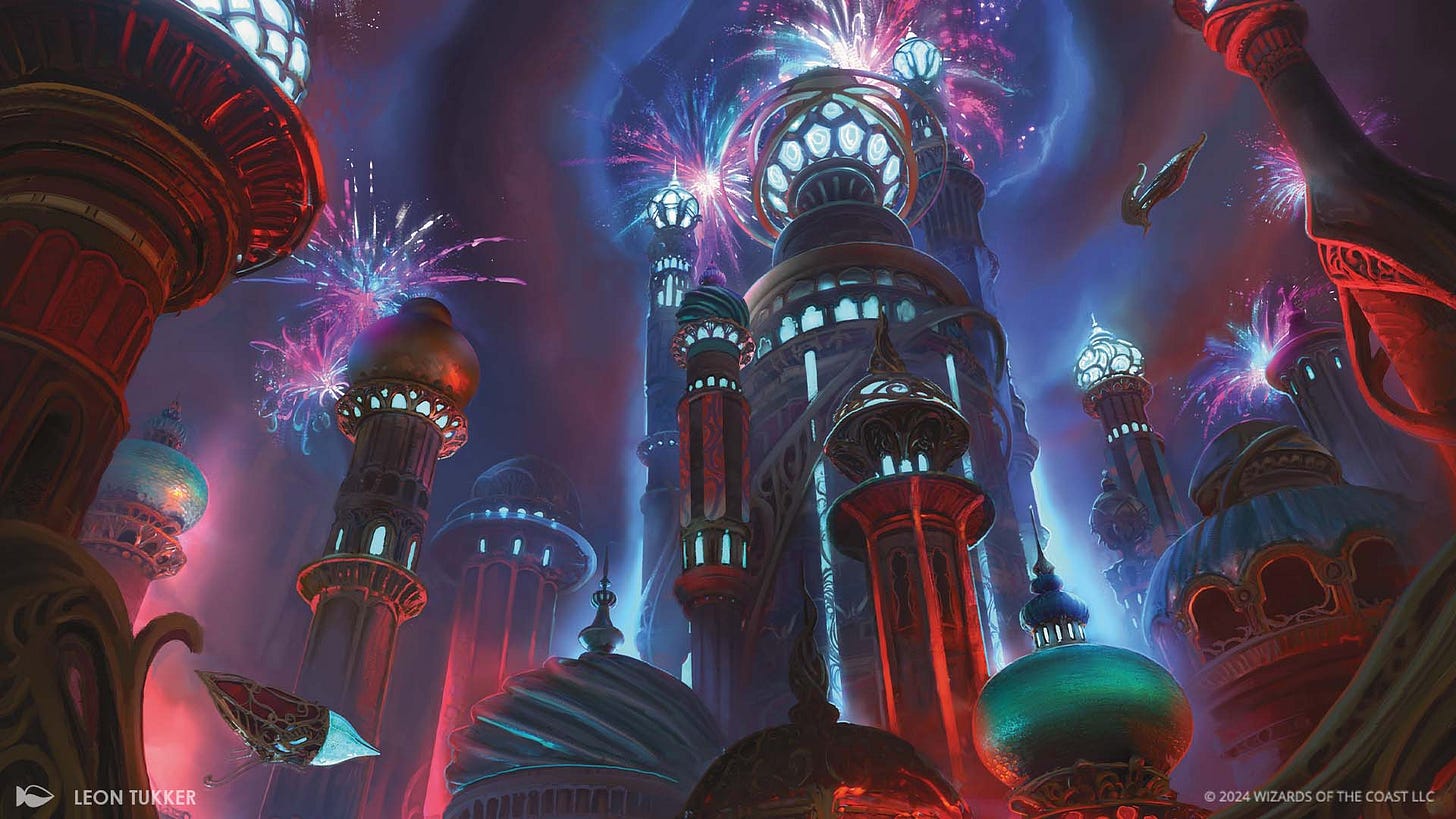
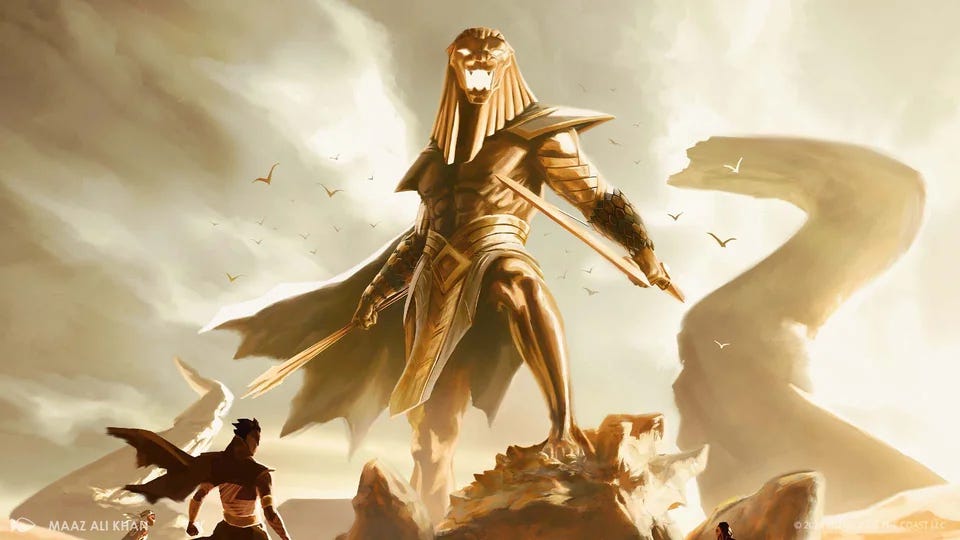
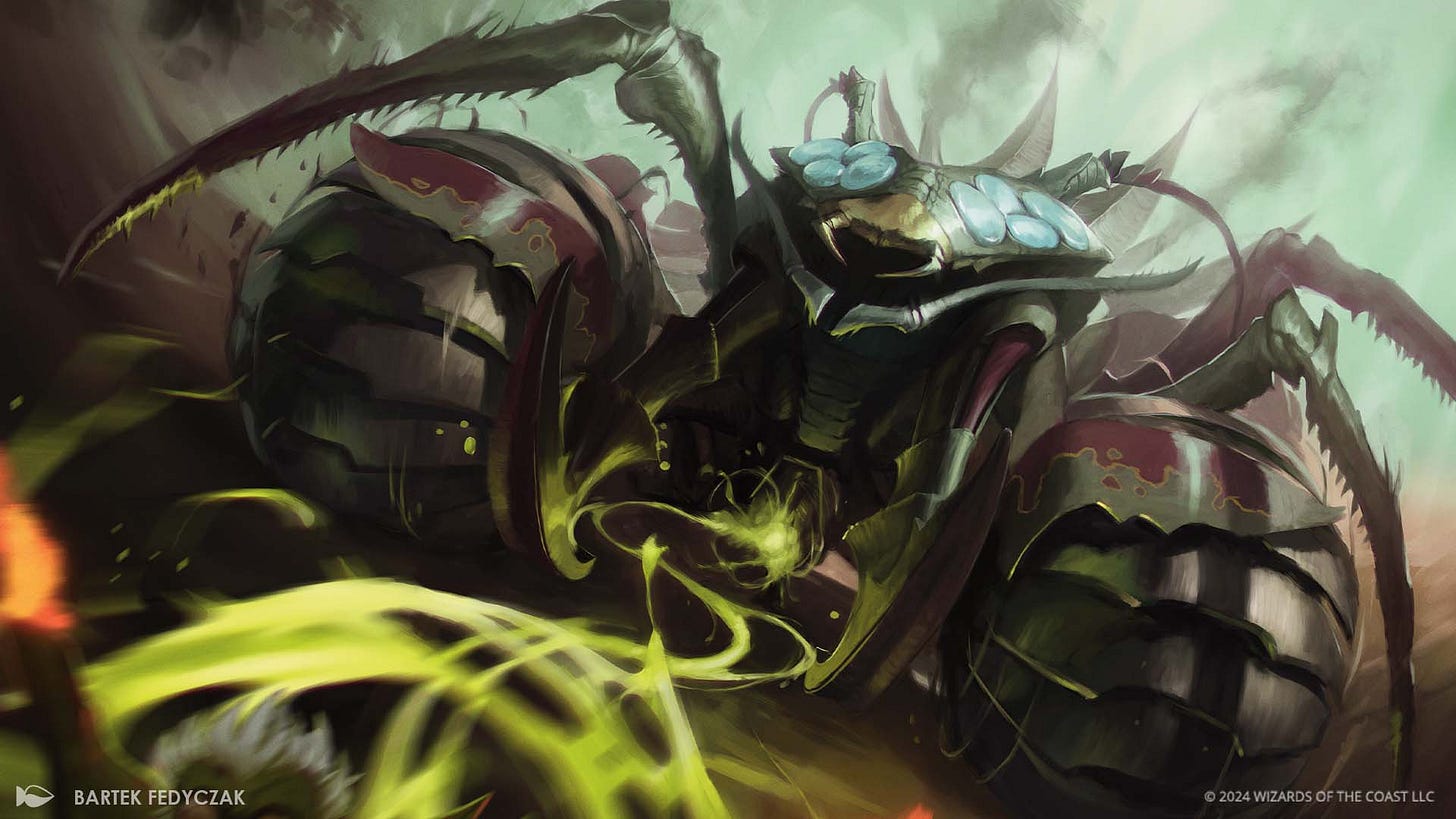
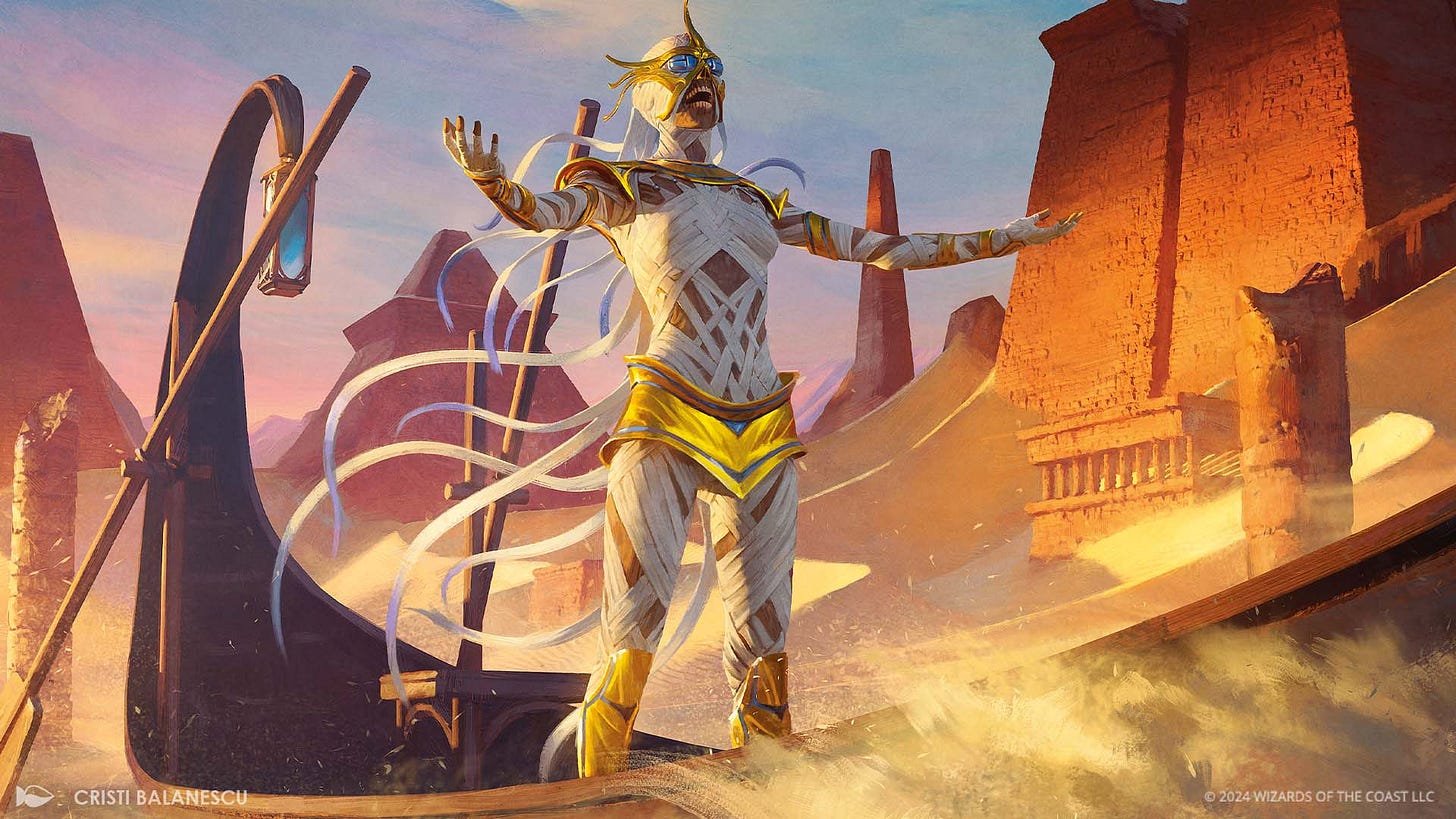
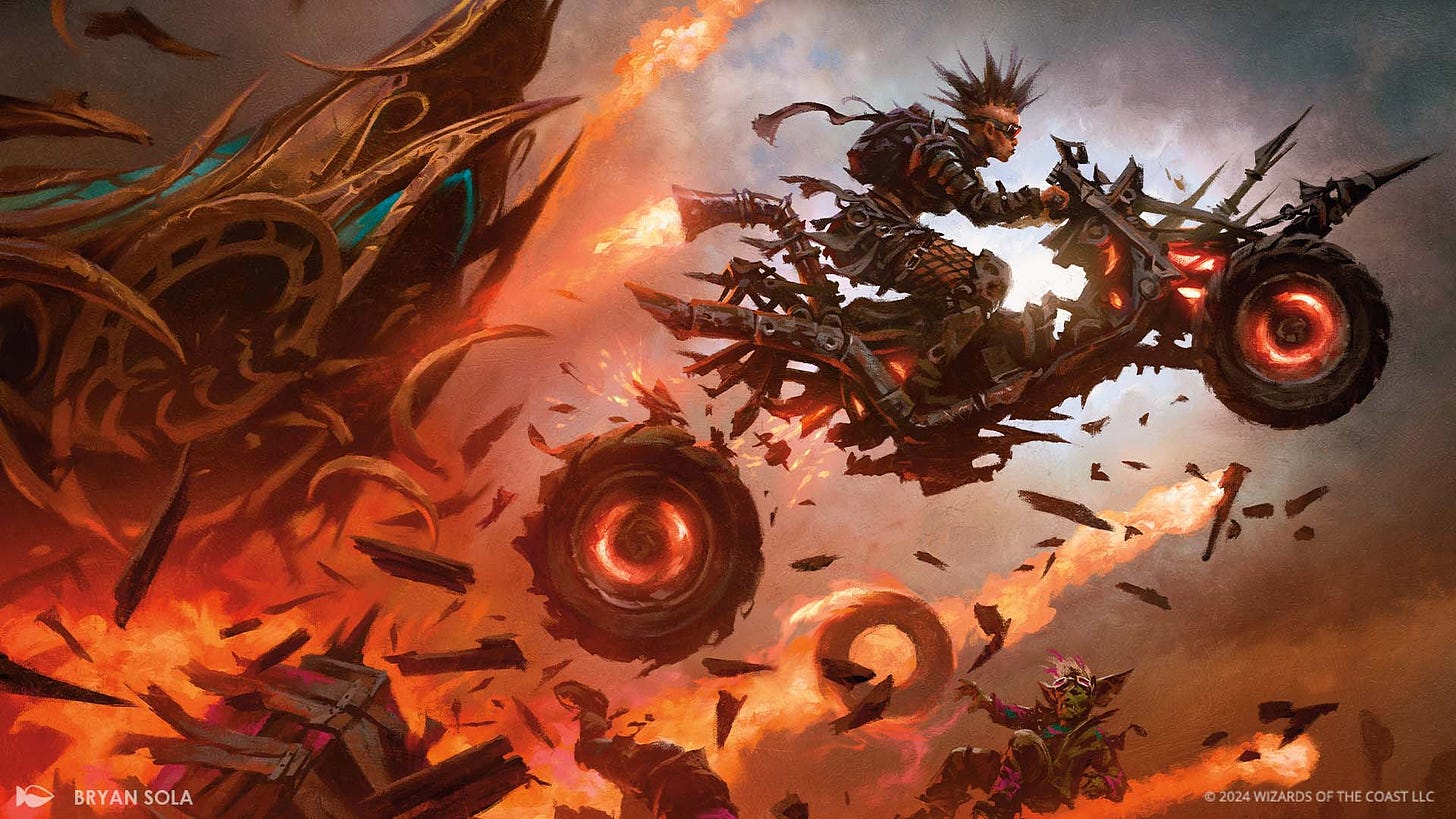
I have never read a world guide and planned to let Aetherdrift miss me completely, but this really gave me compelling reasons to check out both.